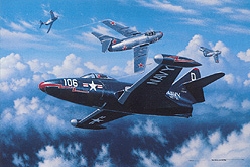|
|
| Good Hunting |
|
 |

|
 |
|
|
| DESCRIPTION |
 |
| 16 x 11.5 Inch Collector Size Unframed Lithograph $40.00
Task Force 77 (including four Carriers) arrived off the coast of Chonjin, North Korea, in the cover of night and bad weather in November of 1952. This was farther north than usual and very close to Soviet air space. The purpose of the mission was to launch air strikes against manufacturing centers in the area of the Yalu River. Lt. Royce Williams was an F9F-5 Panther pilot with VF-781 “Pacemakers” on board the USS Oriskany. The pilots were carefully briefed regarding the proximity to Soviet air space. Williams flew a dawn strike against an industrial complex at Hoeryoung. Upon recovery to the Oriskany, Williams learned that the morning attacks had stirred up Soviet air activity in the Vladivostok area. All follow-on strikes were put on hold until the Soviet activity could be assessed. Around noon Williams suited-up for a combat air patrol flight consisting of four Panthers. Taking off in a light snow storm under a low overcast, the four Panthers climbed to 12,000 feet. Combat Information Center (CIC) radioed the jets to inform them of bogies in their area. As they broke through the cloud cover they could see contrails from seven Migs about thirty miles north, and at much higher altitude. The division lead reported a fuel pump warning light and remained with his wingman at 15,000 feet, while Williams and his wingman climber higher. As the Migs passed directly over Williams he could see them clearly and counted a total of seven. The Migs reversed course and headed north at about 50,000 feet. When they were about thirty miles distant they split into two flights, turned in opposite directions, as to bracket the Panthers, and began descending. Williams lost contact with the bogies as they dropped below contrail altitude. A few minutes later Williams spotted four Migs closing fast from the 10 o’clock position in a loose trail formation. All four were firing. Williams manuevered a rising hard left turn and came in right behind the last Mig in the formation. He fired a burst and the Mig began smoking, dropped its left wing and started to descend. Reporting the hit to CIC, the controller advised “do not engage.” Williams reported back, “I am engaged!” The CIC reported back, “Go get em!” Williams wingman had followed the first Mig down. Minutes later Williams spotted a Mig coming in fast from the 5 o’clock position. He pulled a hard right and kicked a hard reverse, putting the Mig in his sight as it overshot. Although the Mig was pulling away fast, Williams put a burst into him which disintegrated the jet. The turning duel continued for many more minutes, and another Mig began smoking. William’s Panther was eventually hit and he lost his hydraulic system and many of the aircraft controls. Diving for cloud cover, another Mig had settled in behind to finish off the Panther. Fortunately for Williams, his wingman had rejoined the fight despite having jammed guns. He successfully bluffed the Mig on Williams tail to disengage. Williams was able to nurse his badly damaged Panther back to the Oriskany where he had to make a landing at excessive speed. |
|


|